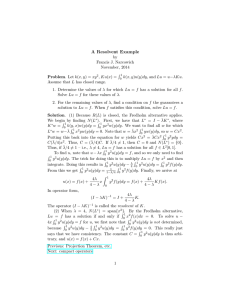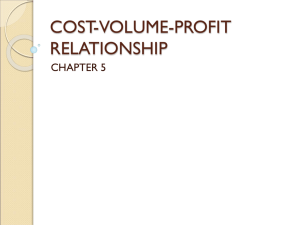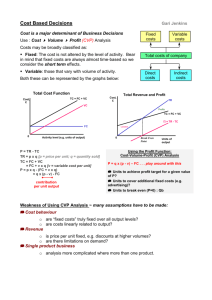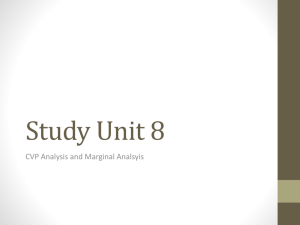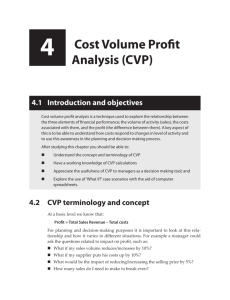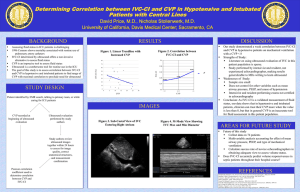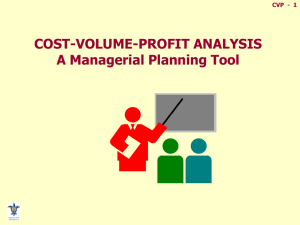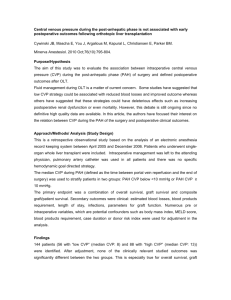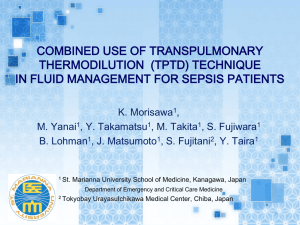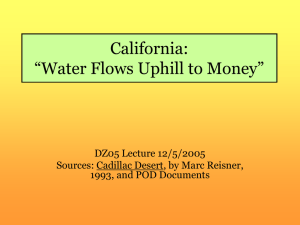review of Chapter 3
advertisement
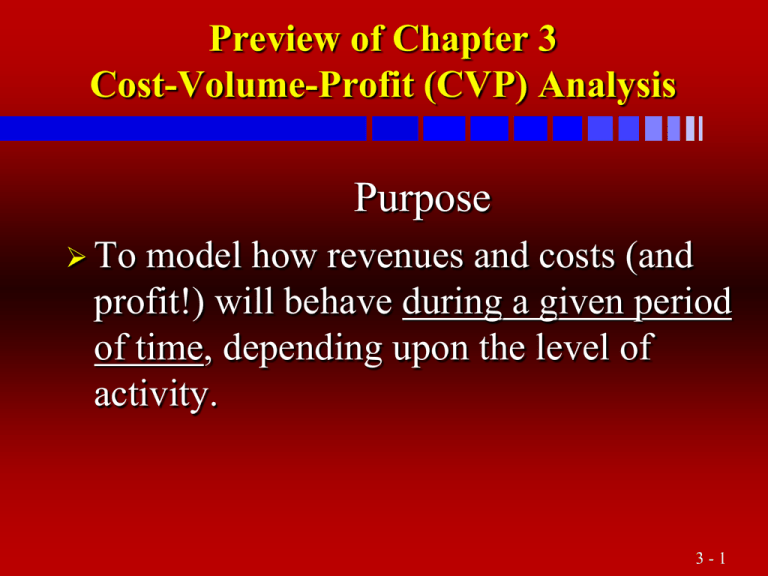
Preview of Chapter 3
Cost-Volume-Profit (CVP) Analysis
Purpose
To
model how revenues and costs (and
profit!) will behave during a given period
of time, depending upon the level of
activity.
3-1
CVP Model
Assumes a contribution margin income statement:
Contribution Mgn Approach vs Absorption Costing
Sales
- Variable Costs:
100%
- VC%
(Var. CGS, Selling, Admin.)
= Cont. Margin
- Fixed Costs:
= CM%
Sales
- CGS
= Gross Margin
- Period Costs
(Selling, Admin.)
(Mfg., Selling, Admin.)
Operating Income
Operating Income
Same only if inventories are constant (production = sales).
3-2
Questions
Besides “Where’s the breakeven point,” other questions
are of more interest:
How will the BEP increase if FC or VC increases?
How much higher could VC/unit rise before we’d
have a loss for the period?
How far could sales drop below the forecast before
Operating Income would fall below last year’s?
3-3
Equations For CVP Analysis
Graphs are for exposition only.
We must solve using equations.
A “definitional” equation, defining income:
Sales – Var Cost – Fixed Cost = Operating Income
–
Good starting point to attack unusual CVP
questions
3-4
Example of Relationships
For a particular item,
Unit Price
$2.50
100%
Unit VC
1.75
70% (VC%)
Unit CM
$ .75
30% (CM%)
3-5
Equations For CVP Analysis
Recognizing that VC and CM are % of sales:
Sales – (VariableCost%)Sales – FixedCost = Operating Income
Contribution Margin
{OR}
Sales x (CM%) – FC = Operating Income
CM
If FC = $10,000, how many must we sell to BE?
S - .7S – 10,000 = 0
.3S = 10,000
S = $33,333 [÷ $2.50 = 13,333 units]
3-6
Other Handy Equation Forms
Sales Dollars = (FC + Oper. Inc.) / CM%
Units Sold = (FC + Oper. Inc.) / (CM per unit)
3-7
Wide Applicability of CVP
CVP applies to any question about proposed
changes in cost structures and related volume
effects.
» Widely applicable.
» Assigned problems are representative.
3-8
Product-Mix Problem
PRODUCT
A
B
C
Price $10
VC
8
CM $ 2
$15
7
$ 8
CM% 20% 53.33%
$25
10
$15
The Weighted
Average CM%
will depend on
actual mix sold
60%
3-9
Product-Mix Problem
Weighted Average based on previous year’s results
(assumed numbers):
A
B
C
Tot. Wtd Avg
Units Sold 5000 10000 15000 30000
Sales
VC
CM
$50,000 150,000
375,000
575,000 1.000
40,000
70,000
150,000
260,000
.452
10,000
80,000
225,000
315,000
.548
3 - 10
Product-Mix Problem
What’s wrong with the following approach?
Product mix is 5/30 “A”, 10/30 “B” and 15/30 “C”
So 5/30 x .20 + 10/30 x .533 + 15/30 x .60 = .511 ≠ .548
Error: Done in terms of units, but the CM% is
contribution/$, not contribution/unit!
Correct:
(50/575)(.20) + (150/575)(.533) + (375/575)(.60) = .548
3 - 11
Considering Income Tax
Recall the “definitional” equation, defining
income:
Sales – Var Cost – Fixed Cost = Operating Income
(1-r)*(Sales – Var Cost – Fixed Cost) = Income after tax
Sales – Var Cost – Fixed Cost = (Income after tax)/ (1-r)
So, divide desired after-tax income by (1-r) to
get the desired before-tax income and use
the formulas as usual.
3 - 12
Effect of Income Taxes
Any
amount “after tax” or net of taxes =
(1-r) (The amount before taxes)
[Applies to an expense, revenue, or Operating Income]
$1,000 expense is tax deductible
So at 40% rate:
(1-.4) 1,000 = $600 net expense
$1,000 revenue is taxable
So at 40% rate:
(1-.4) 1,000 = $600 net
3 - 13
Effect of Income Taxes
All numbers in the CVP equations are before tax.
Therefore questions involving “after tax” effects require
you to convert to “before tax” before using the equation.
Ex. How many units sold to earn $900,000 after tax at a 45% tax
rate?
AT amt. = (1-r) BT amt.
900,000 = (1-.45) BT amt.
BT amt. = 900,000/.55 = $1,636,364
Thus, using my Eq. 4: Units = FC + 1,636,364
CM/unit
3 - 14
